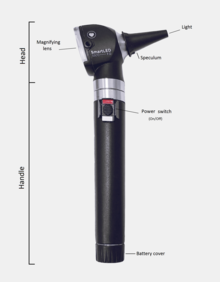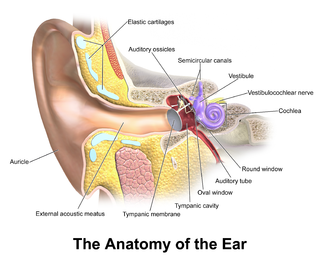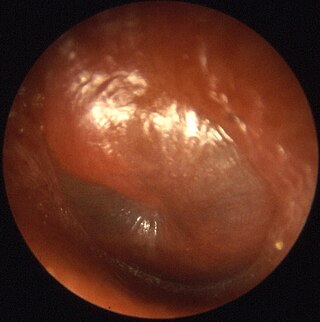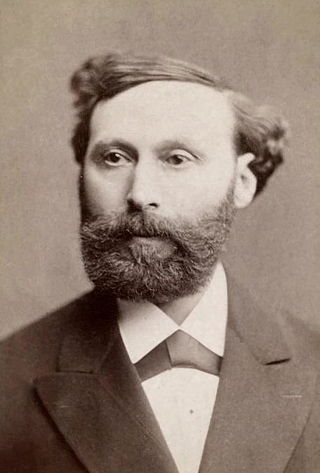| Otoscope | |
|---|---|
 An otoscope, with a tube of disposable tips behind | |
| Synonyms | auriscope |




An otoscope or auriscope is a medical device that a doctor or other health care worker uses to look into a patient's ears. [1] Health care providers use otoscopes to screen for illness during regular check-ups and also to investigate ear symptoms.
Contents
An otoscope gives a view of the ear canal and tympanic membrane or eardrum. Because the eardrum is the border between the external ear canal and the middle ear, its characteristics can indicate various diseases of the middle ear space. The presence of earwax (cerumen), shed skin, pus, canal skin edema, foreign body, and various ear diseases can obscure any view of the eardrum and thus severely compromise the value of otoscopy done with a common otoscope, but confirm the presence of obstructing symptoms.
The most common otoscopes consist of a handle and a head. The head contains a light source and a simple low-power magnifying lens, typically around 8 diopters (3.00x Mag). The distal (front) end of the otoscope has an attachment for disposable plastic ear specula. The examiner first straightens the ear canal by pulling on the pinna (usually the earlobe, side or top) and then inserts the ear speculum side of the otoscope into the external ear. It is important to brace the index or little finger of the hand that holds the otoscope against the patient's head to avoid injury to the ear canal. The examiner then looks through a lens on the rear of the instrument to see inside the ear canal.
In many models, the examiner can remove the lens and insert instruments through the otoscope into the ear canal, such as for removing earwax. Most models also have an insertion point for a bulb that pushes air through the speculum (a pneumatic otoscope). The examiner uses the puff of air to test tympanic membrane mobility.
Many otoscopes for doctors offices are wall-mounted while others are portable. Wall-mounted otoscopes attach to the base by an electrical cord that provides power from an electric outlet. Portable models are powered by batteries in the handle; these batteries are usually rechargeable from a base unit. Otoscopes are often sold with ophthalmoscopes as a diagnostic set.
Diseases that can be diagnosed by an otoscope include otitis media and otitis externa, infection of the middle and outer parts of the ear, respectively. Doctors also use otoscopes to examine patients' noses (avoiding the need for a separate nasal speculum) and (with the speculum removed) upper throats.
Most otoscopes in emergency rooms, pediatric offices, general practice, and by internists—are monocular devices. These provide only a two-dimensional view of the ear canal, its contents, and usually at least a portion of the eardrum, depending on what is within the ear canal and its status. Another method of performing otoscopy (visualization of the ear) is use of a binocular microscope, in conjunction with a larger plastic or metal ear speculum, with the patient supine and the head tilted, which provides a much larger field of view and the added advantages of a stable head, far superior lighting, and most importantly, depth perception. A binocular (two-eyed) view is required in order to judge depth.
If wax or other material obstructs the canal or a view of the entire eardrum, the examiner can easily remove it with specialized suction tips and other microscopic ear instrument—whereas the absence of depth perception a common otoscope makes removing anything harder and more hazardous. Another major advantage of the binocular microscope is that both of the examiner's hands are free, since the microscope is suspended from a stand. The microscope has up to 40x power magnification, which provides more detailed viewing of the entire ear canal, and of the entire eardrum unless edema of the canal skin prevents it.
Subtle changes in the anatomy are much more easily detected and interpreted than with a monocular view otoscope. Traditionally only ENT specialists (otolaryngologists) and otologists (subspecialty ear doctors) acquire binocular microscopes and the necessary skills and training to use them, and incorporate their routine use in evaluating patient's ear complaints. Studies have shown that reliance on a monocular otoscope to diagnose ear disease results in a more than 50% chance of misdiagnosis, as compared to binocular microscopic otoscopy.
The expense of a binocular microscope is only one obstacle to its adoption in general medicine. The low level of familiarity with binocular otoscopy among pediatric and general medicine professors in physician training programs is probably a more difficult obstacle to overcome. Thus, the standard of general otologic diagnosis and ear care remains, for the most part, the largely antiquated monocular otoscope.













